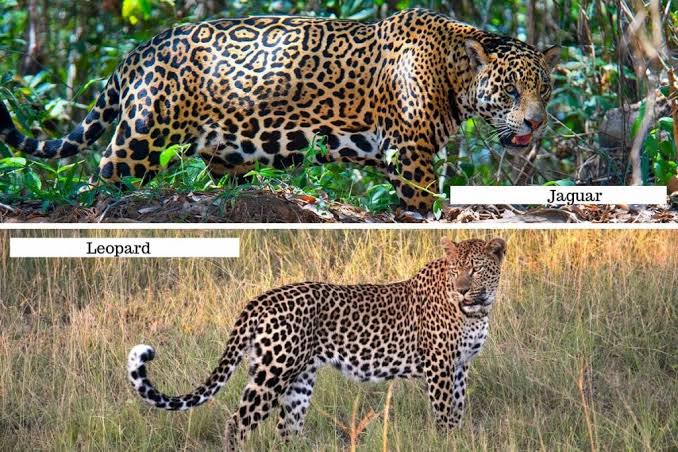
With the mind-blowing variety of species on Earth, it doesn’t come as a surprise that some animals are uncannily similar in build and looks. Sometimes, these animals happen to be close relatives. Some other times, there is barely any link between these creatures – which makes their similarities all the more intriguing. This article discusses some of these animals that are mistaken for each other and their differences. Read on to find out!
- Leopards and Jaguars

These two spotted felines belong to the same genus Panthera, of which tigers and lions are also members. To the untrained eye, these two can be quite difficult to tell apart in footage and pictures. However, here are some differences that could come in handy, if you ever have to do so:
Fur pattern: At first glance, these two have similar golden brown fur with rosette patterns. However, upon closer inspection, there is a striking difference. Jaguars’ rosettes have spots in them. Leopards’ rosettes do not.
Body Size: The leopard is the smallest of the big cats – and therefore usually smaller than the jaguar. Moreover, a jaguar has a stockier, more muscular build than a leopard.
Habitat: Leopards are easily the most widespread of the big cats. They are currently in different parts of Africa, and Asia. Jaguars, on the other hand, are limited to the Americas – especially the rainforests of South America.
Behavior: Jaguars love swimming. Leopards do not, although they are quite good at it. In addition, the leopard has a shyer disposition than the jaguar. This may be due to the preponderance of bigger predators on the former’s turf. Moreover, although they are both stealth hunters, they finish off their prey differently. Jaguars often bite hard on the skulls of their prey to finish them off. Their jaws are that powerful. Leopards are more inclined to choke them off, like lions and tigers.
2. Crocodiles and Alligators

This is a popular pair of animals that are mistaken for each other. Crocodiles and Alligators are reptiles that belong to the same order Crocodylia, meaning they’re less closely related than jaguars and leopards. The Crocodylian order consists of these animals and gharials. Since crocodiles and alligators also have similar diets and niches, it might be easy to mistake them for each other at a glance. But, here are some salient differences.
Snouts and Jaws: Crocodiles have a V-shaped snout. Alligators have a U-shaped snout. Also, alligators often have larger upper jaws than lower jaws, causing the lower teeth to be obscured from view at times. Crocodiles’ jaws are more uniformly sized.
Color: Although it often isn’t easily noticeable from some footage and pictures, alligators have darker-colored bodies, compared to crocodiles. Crocodiles are usually green or brown. Alligators are black or gray.
Size and Temperament: Crocodiles are larger than alligators. Some crocodiles reach almost 2000 pounds. Alligators hardly peak at a thousand pounds. Also, crocodiles are more daring and violent than alligators.It is noteworthy that alligators are less tolerant of saltwater than crocodiles. They often live in freshwater environments. Crocodiles easily thrive in both.
3. Sea Lions and Seals

These two are both pinnipeds – animals that are fin-footed The third member of this group is the walrus. They, however, belong to different families. Seals belong to the family Phocidae while sea lions belong to the family Otariidae. Some subtle differences between seals and sea lions include the following:
Ears: Sea lions have flaps of tissue for their outer ears. Seals, on the other hand, do not. They are “earless”.
Size: Sea lions tend to be bigger than seals. Their overall sizes, weight, and flipper dimensions are more than the seals.
Flippers: The sea lion’s hind flippers are more angulated towards their trunks. It helps them bear their weight and aids walking on land to a degree. Seals’ hind flippers angulate away from the trunk, relatively. Their flippers also can’t rotate like those of sea lions. In addition, seals’ flippers are fur-covered and have claws more visible than the sea lion’s flippers, which are skin-covered and larger.
Movement/Mobility: Sea lions tend to “walk” on land by rotating their hind flippers while seals wriggle around on their bellies. The anatomical peculiarities of seals do not quite favor their mobility on land. But, it does in water, making them more agile swimmers than sea lions.Pose and
Behavior: Seals have a “banana” pose. Sea lions have a “yoga” pose. Moreover, seals are usually loners. They are also quite quiet. Sea lions, on the other hand, are noisy, social animals.
4. Wasps and Bees

If the animals above are not quite relatable, perhaps a comparison between two of the most familiar insects should appeal to you. Bees and wasps are of the same order Hymenoptera. Like the aforementioned animals, at first glance, they look alike. However, because of their stingers, many usually don’t hang around long enough to ascertain either’s identity. Nonetheless, here are some of their differences.
Diet: Bees feed on nectar and plant pollen from flowers. Wasps, on the other hand, have a more diverse diet consisting of insects, nectar, and/or fruit. Their choice of food at any point depends on the species and the life stage.
Build: Wasps have sleek, non-hairy (and usually longer) bodies with slender legs. This anatomy is well-suited for hunting, and agile movements in the air. Bees, on the other hand, possess hairy or fuzzy body that helps collect pollen for pollination. In addition, bees are not sleekly built. They are “wider” – more full-bodied.
Stingers and Color: Wasps are capable of multiple stings. Bees are not. This is because they tear off their abdomen when they try to pull out their stinger. Furthermore, wasps have distinct black/yellow bands on their abdomen. Bees, on the other hand, have less-defined bands of dark and light (almost yellowish) shades of brown.
For more wildlife pieces, click here.



Leave a Reply